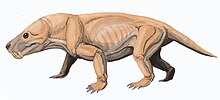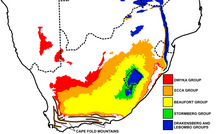Moschorhinus
| Moschorhinus | |
|---|---|

| |
| Restoration of Moschorhinus kitchingi | |
| Scientific classification | |
| Domain: | Eukaryota |
| Kingdom: | Animalia |
| Phylum: | Chordata |
| Clade: | Synapsida |
| Clade: | Therapsida
|
| Clade: | †Therocephalia |
| Family: | †Akidnognathidae |
| Genus: | †Moschorhinus Broom, 1920 |
| Species: | †M. kitchingi
|
| Binomial name | |
| †Moschorhinus kitchingi Broom, 1920
| |
| Synonyms | |
| |
Moschorhinus is an
Moschorhinus appears to have ecologically replaced the
Taxonomy
The genus name Moschorhinus is derived from the Ancient Greek words μόσχος (mos'-khos) moschos for calf or young animal, and rhin/rhino- for nose or snout, in reference to its short, broad snout. The species name, kitchingi, refers to Mr. James Kitching, who originally found (but did not describe) the specimen.[2]
Kitching discovered the
Broom had previously named another species of therocephalian in 1907 from KwaZulu-Natal, Scymnosaurus warreni, that he later moved to Moschorhinus in 1932 as M. warreni, maintaining it as a distinct species. M. warreni was later recognised as a probable synonym of M. kitchingi by Kitching in his unpublished PhD thesis, and a re-description of the holotype in 2023 by David Groenewald and Christian Kammerer confirmed this proposal. As the older name, M. warreni would have taxonomic priority over M. kitchingi for the species. However, Groenewald and Kammerer (2023) believed it would be premature to establish M. warreni as the correct name, pending a revision of akidnognathid therocephalian taxonomy and the possibility that even older names may have seniority.[1]

Moschorhinus remains have been found most prominently in the
Classification
Moschorhinus is a
Moschorhinus took over the
Description

Moschorhinus was a large carnivore, reaching 1.5 m (4.9 ft) in total body length.
Lateral view of Moschorhinus jaw, showing range of motion necessary for such large incisors, and upper palatal fenestrae of snout. (From van Valkenburgh and Jenkins, 2002).[6]
Snout
The snout of Moschorhinus is characteristically short and broad. The blunt tip of the snout features a ridge running down the midline to the frontal bone.[6][4] The lower jaw is much broader than that of any other therocephalian.[6][4] The upper snout projects a bit beyond the incisors in juveniles.[4]
The nostrils were large and positioned towards the tip of the snout.[4]
Teeth
Moschorhinus is thought to have had a
The incisors are housed in the premaxillae. They are large, curve slightly, and have a bell-shaped cross-section. They had smooth cutting surfaces, and, unlike those of other therocephalians, lacked facets or striae resulting from abrasion and wear.[4]
The large saber-like canines are held within the maxillae, and are quickly identifiable features of Moschorhinus. They are especially thick and strong, and uniquely circular in cross-section. In length, these sabers are comparable to gorgonopsids. While there is no real modern analogue, the most similar living example would be the clouded leopard (Neofelis nebulosa).[6]
Like other therocephalians, Moschorhinus had a reduced number of postcanines which were housed in the maxillae. In most therocephalians, the “teeth,” or rather toothlike projection (denticulations) of the pterygoid bones, are greatly reduced or missing, and in Moschorhinus they are absent.[4][9]
Skull roof
Tracing the roof of the skull, Moschorhinus possesses small
Eye sockets
The
Palate
Overall, the palate is convex, with a broad, triangular vomer, with paired tubercles, rounded projections pointing ventrally,[6][4] similar to other akidnognathids.[2] The palatine bones (forming the back of the roof of the mouth) are enlarged and thick, especially on their outer edges where they are joined to the maxilla. On their inner edges, the palatines are joined to the pterygoid and vomer on the nose, forming part of the circumference of the nasal cavity. Between the palatine and maxilla, just behind the canines, are large foramens, presumably to allow for nerves. A slanting ridge along the middle of the palatine presumably supported a soft palate, which allowed air to travel between the nose and the lungs.[6]
The sabers require the mouth to open widely for use, making feeding difficult. The closely related Promoschorhynchus shows stiff folds (choanal crest) on the border of the nasal passage and the throat, used to keep it open and to allow for breathing while eating. The development of a secondary palate in the skull gradually evolved in therocephalians, and the choanal crest is featured in all later therocephalians.[9]
Paleobiology

It is presumed that Moschorhinus was a cat-like predator, being able to pierce skin and hold onto struggling prey with its long canines. This is the first record of this kind of hunting technique. Given its sturdily designed, thick snout, enormous canines, and powerful jaw muscles, Moschorhinus appears to have been a daunting predator.[6]
Paleoecology
Many vertebrate fossils have been uncovered in the Karoo Basin. Other therocephalians from the same rock level are Tetracynodon and Promoschorhynchus.[3] Moschorhinus specimens were the only large therocephalians.[11][4]
Moschorhinus seems to have gone extinct in the Early Triassic at 251 mya after the
References
- ^ hdl:10539/37143.
- ^ a b c d e f Broom R (1920). "On Some New Therocephalian Reptiles from the Karroo Beds of South Africa". Proceedings of the Zoological Society of London: 351–354.
- ^ S2CID 86490421.
- ^ a b c d e f g h i j k l m Huttenlocker, Adam (2013). The Paleobiology of South African Therocephalian Therapsids (Amniota, Synapsida) and the Effects of the End-Permian Extinction on Size, Growth, and Bone Microstructure (Ph.D). University of Washington.
- .
- ^ doi:10.1017/S1089332600001121. Archived from the original(PDF) on 2013-10-17.
- doi:10.1111/j.1502-3931.2007.00011.x. Full version online at "Lystrosaurus species composition across the Permo–Triassic boundary in the Karoo Basin of South Africa" (PDF). Archived from the original(PDF) on 2008-09-10. Retrieved 2008-07-02.
- (PDF) from the original on 19 Mar 2023.
- ^ .
- ^ Durand J F (1991). "A revised descripction of the skull of moschorhinus (therapsida, therocephalia)". Annals of the South African Museum. 99: 381–413.
- ^ S2CID 128981733.
- S2CID 46198018.
- ]
- PMID 12965004.
- .
